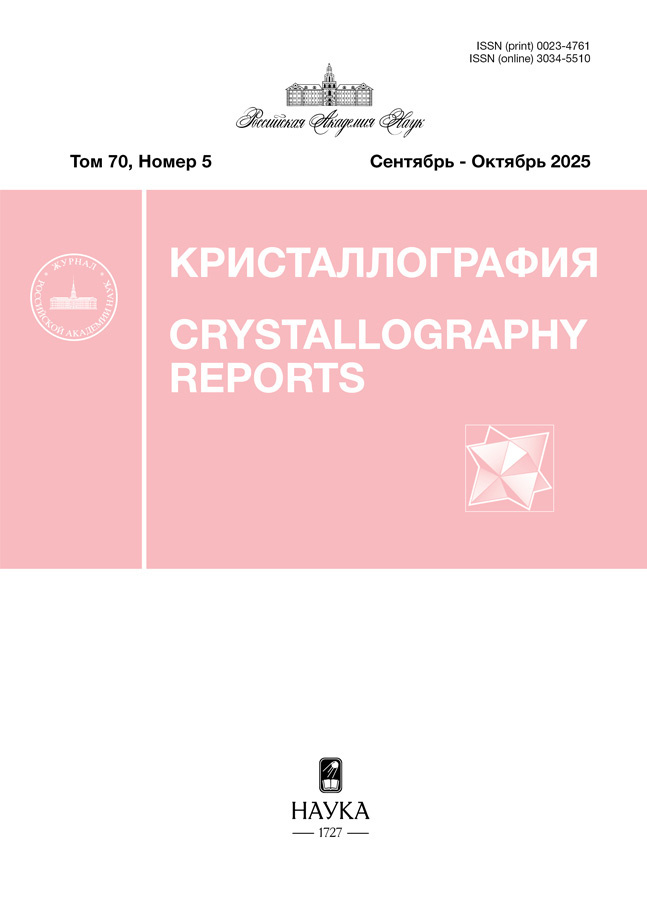Localization of aluminum in ZnO: Al layers during magnetron sputtering deposition
- Authors: Asvarov A.S.1, Muslimov A.E.1, Kanevsky V.M.1, Akhmedov A.K.2, Abduev A.K.3, Kalazhokov Z.K.4
-
Affiliations:
- Shubnikov Institute of Crystallography of Kurchatov Complex of Crystallography and Photonics of NRC “Kurchatov Institute”
- Amirkhanov Institute of Physics, Dagestan Federal Research Center, Russian Academy of Sciences
- The Federal State University of Education
- H. M. Berbekov Kabardino-Balkarian State University
- Issue: Vol 69, No 2 (2024)
- Pages: 303-313
- Section: ПОВЕРХНОСТЬ, ТОНКИЕ ПЛЕНКИ
- URL: https://gynecology.orscience.ru/0023-4761/article/view/673211
- DOI: https://doi.org/10.31857/S0023476124020147
- EDN: https://elibrary.ru/YSGBUY
- ID: 673211
Cite item
Abstract
The features of aluminum localization and the mechanism of donor center formation in ZnO:Al layers synthesized by high-frequency magnetron sputtering are studied. It is shown that aluminum predominantly localizes at grain boundaries of zinc oxide in its own oxide phase. The mechanism of aluminum oxidation at grain boundaries significantly depends on the oxygen content in the working chamber: during sputtering in an atmosphere of pure argon under conditions of oxygen deficiency, aluminum oxidation occurs as a result of interaction with oxygen from the surface layer of zinc oxide crystallites, forming surface donor centers at grain boundaries. With an increase in the partial pressure of oxygen, aluminum is predominantly oxidized by oxygen from the gas atmosphere, forming its own barrier phase at grain boundaries.
Full Text
About the authors
A. Sh. Asvarov
Shubnikov Institute of Crystallography of Kurchatov Complex of Crystallography and Photonics of NRC “Kurchatov Institute”
Email: a_abduev@mail.ru
Russian Federation, Moscow
A. E. Muslimov
Shubnikov Institute of Crystallography of Kurchatov Complex of Crystallography and Photonics of NRC “Kurchatov Institute”
Email: a_abduev@mail.ru
Russian Federation, Moscow
V. M. Kanevsky
Shubnikov Institute of Crystallography of Kurchatov Complex of Crystallography and Photonics of NRC “Kurchatov Institute”
Email: a_abduev@mail.ru
Russian Federation, Moscow
A. K. Akhmedov
Amirkhanov Institute of Physics, Dagestan Federal Research Center, Russian Academy of Sciences
Email: a_abduev@mail.ru
Russian Federation, Makhachkala
A. Kh. Abduev
The Federal State University of Education
Author for correspondence.
Email: a_abduev@mail.ru
Russian Federation, Mytishchi
Z. Kh. Kalazhokov
H. M. Berbekov Kabardino-Balkarian State University
Email: a_abduev@mail.ru
Russian Federation, Nalchik
References
- Boscarino S., Crupi I., Mirabella S. et al. // Physica A. 2014. V. 116. P. 1287. https://doi.org/10.1007/s00339-014-8222-9
- Afre R.A., Sharma N., Sharon M. et al. // Rev. Adv. Mater. Sci. 2018. V. 53. P. 79.
- Cohen D.J., Barnett S.A. // J. Appl. Phys. 2005. V. 98. P. 053705. https://doi.org/10.1063/1.2035898
- Akhmedov A., Abduev A., Murliev E. et al. // Materials. 2023. V. 16. P. 3740. https://doi.org/10.3390/ma16103740
- Meng F., Ge F., Chen Y. et al. // Surf. Coat. Technol. 2018. V. 365. P. 2. https://doi.org/10.1016/j.surfcoat.2018.04.013
- Abduev A., Akhmedov A., Asvarov A. et al. // SID Symposium Digest of Technical Papers. 2019. V. 50. P. 977. https://doi.org/10.1002/sdtp.13089
- Asvarov A.S., Abduev A.K., Akhmedov A.K. et al. // Materials. 2022. V. 15. P. 5862. https://doi.org/10.3390/ma15175862
- Ellmer K., Mientus R. // Thin Solid Films. 2008. V. 516. P. 5829. https://doi.org/10.1016/j.tsf.2007.10.082
- Wu Y., Giddings A.D., Verheijen M.A. et al. // Chem. Mater. 2018. V. 30. P. 1209. https://doi.org/10.1021/acs.chemmater.7b03501
- Jose J., Khadar M.A. // Mater. Sci. Eng. A. 2001. V. 304–306. P. 810. https://doi.org/10.1016/S0921-5093(00)01579-3
- Reiche M., Kittler M., Krause H.M. // Solid State Phenom. 2013. V. 205–206. P. 293. https://doi.org/10.4028/www.scientific.net/ssp.205-206.293
- Лашкова Н.А., Максимов А.И., Матюшкин Л.Б. и др. // Бутлеровские сообщения. 2015. Т. 42. № 6. С. 48.
- El-Shaarawy M.G., Khairy M., Mousa M.A. // Adv. Powder Technol. 2020. V. 31. P. 1333. https://doi.org/10.1016/j.apt.2020.01.009
- Liu J., Huang X., Duan J. et al. // Mater. Lett. 2005. V. 59. P. 3710. https://doi.org/10.1016/j.matlet.2005.06.043
- Abduev A., Akhmedov A., Asvarov A. // J. Phys. Conf. Ser. 2011. V. 291. P. 012039. https://doi.org/10.1088/1742-6596/291/1/012039
- Khlayboonme S.T., Thowladda W. // Mater. Res. Express. 2021. V. 8. P. 076402. https://doi.org/10.1088/2053-1591/ac113d
- Nasr B., Dasgupta S., Wang D. et al. // J. Appl. Phys. 2010. V. 108. P. 103721. https://doi.org/10.1063/1.3511346
- Novák P., Kozák T., Šutta P. et al. // Phys. Status Solidi. A. 2018. V. 215. https://doi.org/10.1002/pssa.201700951
- Sieber I., Wanderka N., Urban I. et al. // Thin Solid Films. 1998. V. 330. P. 108. https://doi.org/10.1016/S0040-6090(98)00608-7
- Bikowski A., Rengachari M., Nie M. et al. // APL Mater. 2015. V. 3. P. 060701. https://doi.org/10.1063/1.4922152
- Fiermans L., Vennik J., Dekeyser W. // J. Surf. Sci. 1975. V. 63. P. 390.
- Semiletov A.M., Chirkunov A.A., Grafov O.Y. // Coatings. 2022. V. 12. P. 1468. https://doi.org/10.3390/coatings12101468
- Potter D.B., Parkin I.P., Carmal C.J. // RSC Adv. 2018. V. 8. P. 33164. https://doi.org/10.1039/c8ra06417b
- Daza L.G., Martin-Tovar E.A., Castro-Rodriguez R. // Inorg. Organomet. Polym. 2017. V. 27. P. 1563. https://doi.org/10.1007/s10904-017-0617-6
- Li L., Fang L., Zhou X.J. et al. // J. Electron Spectros. Relat. Phenomena. 2009. V. 173. P. 7. https://doi.org/10.1016/j.elspec.2009.03.001
- Tong C., Yun J., Chen Y.-J. et al. // ACS Appl. Mater. Interfaces. 2016. V. 8. P. 3985. https://doi.org/10.1021/acsami.5b11285
- Sky T.N., Johansen K.M., Venkatachalapathy V. et al. // Phys. Rev. B. 2018. V. 98. P. 245204. https://doi.org/10.1103/PhysRevB.98.245204
- Kim H.-K., Seong T.-Y., Kim K.-K. et al. // Jpn. J. Appl. Phys. 2004. V. 43. P. 976. https://doi.org/10.1143/JJAP.43.976
- Wei J., Ogawa T., Feng B et al. // Nano Lett. 2020. V. 20. P. 2530. https://doi.org/10.1021/acs.nanolett.9b05298
- Моррисон С. Химическая физика поверхности твердого тела. М.: Мир, 1980. 488 с.
- Ryabko A.A., Mazing D.S., Bobkov A.A. et al. // Phys. Solid State. 2022. V. 64. P. 1657. https://doi.org/10.21883/PSS.2022.11.54187.408
Supplementary files

















